
|   |

|   |
 e-mail: sunilkothari1933@gmail.com My early association with Guru Kelucharan Mohapatra July 12, 2020 I owe my introduction to Kelubabu to Babulal Doshi. It was in 1958 All India Dance Seminar held by Sangeet Natak Akademi at Vigyan Bhavan in New Delhi from 31st March till 7th April, where a galaxy of pioneers of Indian classical dance had got together, taking stock of the dance in India, Sri Lanka and Nepal.  Kavichandra Kali Charan Patnaik Photo courtesy: Kala Vikash Kendra It was also for the first time that Odissi dance was presented with demonstration by young Guru Deba Prasad Das and one young dancer by name Jayanti Ghosh who had rendered abhinaya. The renowned scholar Kavichandra Kali Charan Patnaik had presented a paper on Odissi. Before the presentation of Odissi in the Akademi, I had read in Bombay University a small booklet Orissi Dance, by Kavichandra Kali Charan Patnaik with a cover photo of Priyambada Mohanty. Inside that small booklet were other photos of Priyambada demonstrating various poses of Odissi. It was in September 1957 that Marg Publications of Dr. Mulk Raj Anand had brought out a special issue devoted to Bharatanatyam, edited by Mohan Khokar. I had read it from cover to cover and wanted to translate in Gujarati his article on Kuchipudi and Bhagavata Mela Natak. After I met Dr. Mulk Raj Anand in Mumbai, he gave me a letter to Mohan Khokar and advised me to go and see him in Baroda where he was a Professor of Dance at M.S. University. Our friednship started from there. I was also to meet Mrinalini Sarabhai at Ahmedabad. Both Mohan Khokar and Mrinalini suggested that I should attend the All India Dance Seminar in New Delhi in April 1958. Meanwhile, I had registered for Chartered Accountancy, but my heart was not in becoming an accountant. Attending the dance seminar, meeting these great stalwarts, gurus, performers, scholars, connoisseurs, I decided to complete CA but start research in Indian dance. 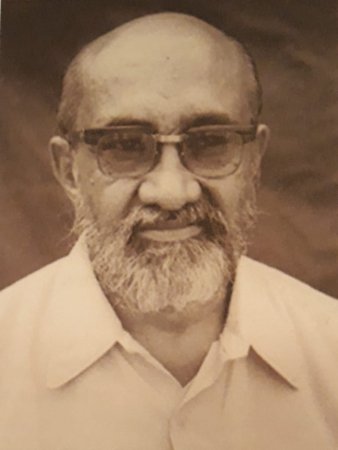 Babulal Doshi Photo courtesy: Kala Vikash Kendra In one of the morning sessions of the seminar, I was talking with Mrinalini Sarabhai in Gujarati. Listening to the Gujarati language, a middle aged gentleman joined us introducing himself as Babulal Doshi. He had established Kala Vikash Kendra institute in Cuttack to train young children in Odissi dance. He was a close associate of Kamala Devi Chattopadhyaya, the Vice Chairman of the Akademi and a socialite. He had taken a wow not to wear chappals till he built a building for Kala Vikash Kendra. We were quite fascinated listening to his story. When he came to learn that I was a Gujarati belonging to middle class bania family who were Vaishnavas, he spoke of Puri Jagannath and invited me to visit Puri and also Cuttack. During the conference, Kavichandra Kali Charan presented the paper. Sanjukta Panigrahi (nee Mishra) was also there to see him. She was studying Bharatanatyam under Rukmini Devi at Kalakshetra along with Mayadhar Raut. During the seminar, Rukmini Devi presented Kutrala Kuravanji dance drama in the evening in which Sanjukta was performing Bharatanatyam. Babulal Doshi told me that she had also studied Odissi under Guru Kelucharan Mohapatra. That was the first time I heard the name of Guru Kelucharan Mohapatra. I did not meet him during the seminar, though I am told that he had come to accompany Jayanti Ghosh. If so, Babubhai would have introduced me. I first met Guru Kelucharan Mohapatra in 1959 when during Oriental Conference held in Bhubaneswar under the chairmanship of Dr. Harekrushna Mehtab, another young scholar and dancer Dhirendra Pattnaik presented Dashavatara item. I was told that the young person who accompanied him on pakhavaj was none other than Guru Kelucharan Mohapatra. 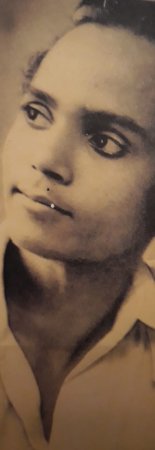 Young Kelubabu 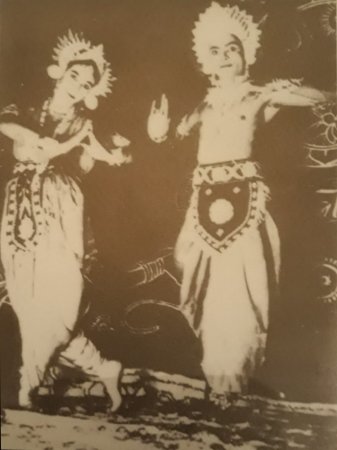 Laxmipriya & Kelucharan Mohapatra in Dashavatar first performed in 1947 in Sadhaba Jhia play at Annapoorna Theatre B, Cuttack Photos courtesy: Ratikant Mohapatra I have vague memory of having seen Guruji. The real encounter happened when Babubhai Doshi in order to raise funds for building of Kala Vikash Kendra brought a troupe of dancers, including Gotipua dancers, Mayurbhanj Chhau dancers with huge drum dhumsa and young dancers including Kum Kum Das to perform at Birla Theatre in Mumbai. It was before the performance that Guruji was doing make up for Kum Kum. Babubhai took me to Kelubabu and I folded my hands and touched his feet. Guruji with a warm smile embraced me and blessed me. I have never forgotten that affectionate gesture of Guruji. It left a deep impression on me. He was indeed a great guru but with such loving care he would do make up for the young dancers. They all were like is daughters and he was so proud and fond of them that he personally looked after their costumes, makeup and other paraphernalia. The program was a huge success. Babubhai had gathered Vaishnav Gujarati community of Mumbai who donated large sums of money for the building of Kala Vikash Kendra. Babubhai had roped me in the raising of the funds, met my mother and told her that she and I should visit Puri again for darshan and be his guest at Cuttack and see Odissi dance by these young dancers. It was during that time that Babulal Doshi suggested that I should come to Cuttack during vacations and stay with him, meet scholars, watch classes conducted by Guru Kelucharan Mohapatra and write a book on Odissi. He had meanwhile published an Annual Journal titled 'Kala Vikash' under the banner of Kala Vikash Kendra. 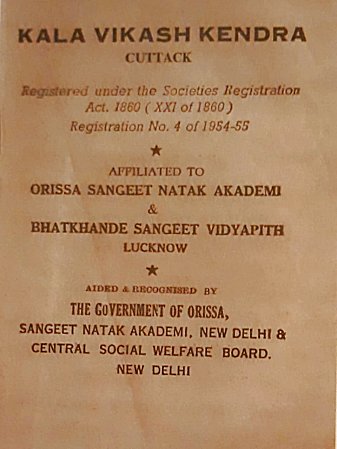 Kala Vikash Kendra booklet 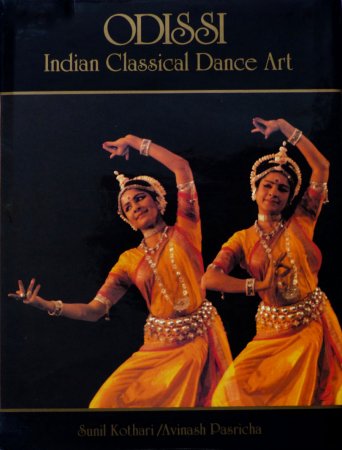 Book on Odissi with photos by Avinash Pasricha In his residence Kesar Nivas in Oriya Bazar in Cuttack, I used to stay for nearly two months browsing through various books on Odisha in English and also various articles on Odissi in Kala Vikash Journal. In the evening, I would go to Kala Vikash Kendra and attend classes by Guruji. Those were the days when everyone was encouraging Odissi. Guruji's style of teaching was meticulous. He was of a medium height, had then lot of black hair, he always wore a gentle smile and dressed in white dhoti and kurta, he would teach young dancers how to keep balance while taking chauka. His body was proportionate and when he struck chauka one could see the perfect square position. I had studied Kathak and Bharatanatyam and could see how a Bharatanatyam dancer had to keep araimandi position with outward kshipta position of knees as fundamental pose from where the movements would emanate. Watching daily classes, seeing young Kum Kum (who became very friendly with me as she resembled my young niece) taking revolutions, circles and mastering various aspects of chauka, tirbhanga as Guruji would explain, I started to understand the basic technique though Guruji's training and explanations. Guruji also used to then teach Kum Kum at her residence. I used to accompany Guruji to Kum Kum's residence where I met her father Bama Charan Das and her mother, who were very hospitable. I had my first 'pakhala bhaat' at Kum Kum's residence. With Guruji, it was not only learning and observing the technique but also the way Guruji would draw attention to various aspects of life one led in Odisha. In particular, Guruji observed how Kum Kum's mother would sit, prepare the vegetables, including betel leaf paan. Later on he used to tell us that the grace of a nayika he invested in his roles of nayikas, were drawn by observing Kum Kum's mother's womanly grace and actions.  Early dance dramas choreographed at Kala Vikash Kendra staged at Annapoorna Theatre B at Cuttack during Raja Utsav, 1973-74 Photo courtesy: Rohini Dandavate My annual visits were thus becoming rewarded. Those were the years when Odissi was developing and Guruji with his extraordinary imagination, and ability to make the movements more lyrical and graceful was enriching the repertoire. The music which was created by violinist Bhubaneswar Mishra, a disciple of Dwaram Venkataswamy Naidu of Andhra, was melodious and Guruji's pakhavaj playing and Bhubaneswar Mishra's violin playing, the creation of the evergreen pallavis Sankarabharanam and Arabhi cast a spell on those who witnessed the creation. I did not then realize that I was watching the great creation of pallavis, often drawing inspiration from the songs which were sung orally, and its tunes were turned into the music for pallavis. Much later, I realized when Guruji would sing the song like Dekhi mu para asare prana sangini bansidhar bes ku… was set to Kalyan pallavi. I was fortunate to grow up with Guruji, Bhubaneswar Mishra, Minati Mishra, Kum Kum, and Sanjukta who were involved in creation of not only a classical dance form but also an everlasting repertoire by Guru Kelucharan Mohapatra. If later on I received encomiums for my research in Odissi, I entirely owe it to Guruji and others involved in these artistic activities. I also came in close touch with Guru Pankaj Charan Das and Guru Deba Prasad Das, but without hesitation I would say that it was Guru Kelucharan Mohapatra who gave me insights into the process of how Odissi dance, its nritta and abhinaya were developing. I felt close to him like purva janma rinanubandha. The more I stayed with Guruji, the more I became devoted to him. And in return I received his love. In sixties and seventies I was very close to him and when Guruji started visiting Mumbai, and I invited Guruji to demonstrate during Kal Ke Kalakar festivals for Brijnarain-ji at C.J. Hall from 1970 to 1980, people associated me with Guruji. 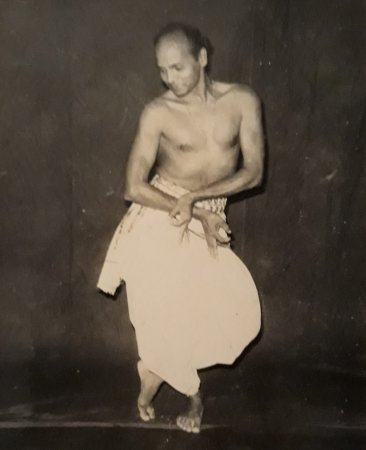 Kelubabu from a series of photos taken in Mumbai for NCPA journal by Subodh Chandra 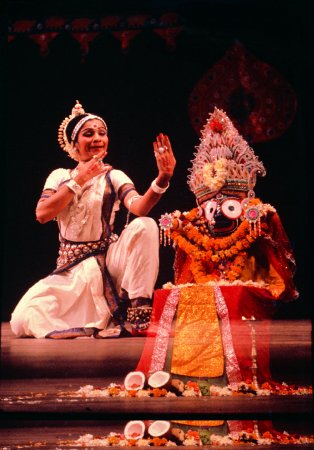 Sanjukta Panigrahi (Photo by Avinash Pasricha) It was a privilege to work with Guruji. When we first presented him at C.J. Hall, I wanted him to take off his vest so that the movements of the torso could be seen clearly. In the beginning he was hesitant, but later on he removed it. His movements of torso, vakshachalan was magical. Without moving his hips, the way he moved the torso made audience understand how different Odissi as a dance form was. Even during the All India Dance Seminar, the impression other scholars had was that Odissi was a variation of Bharatanatyam. Guruji dispelled that notion with demonstration of the technique which he developed over the years. The sama bhanga, abhanga, tribhanga and atibhanga distinguished Odissi. Guruji would demonstrate the gaits, chaals, Meendandi, and the way he would place sole, move feet, creating pattern of the fish moving surprised the audiences. Dancing on heels lifting the upper part of soles was typical. The hastas executed had acquired finish. Spreading the fingers of palm and placing one upon another, he would create the trellis of a window through which a nayika looks for arrival of Krishna. Often Guruji would take some of us to Parasurameswara temple and show us sculptures of chauka, atibhanga, trellis of a window, and he would draw attention to sculptures carved on the ceilings of Mukteshwar temple. To go with Guruji to Konark was always a lesson in studying the lexicon of Odissi dance, as poses inspired from the sculptures. He would draw attention to small figures of nayikas in the spokes of the wheels of the chariot. The way a nayika would be in alasa, sitting royally with her arm across her knee, or lacing one arm in front and bending head, ah… the sculptures would come to life! That he drew inspiration from sculpture to embellish dance inspired us to write that Odissi dance was sculpture come alive and sculptures were frozen dance. Guruji used to perform abhinaya to 'To laagi gopa danda mana re Kaliya suna' of gopi admonishing Krishna that on account of his pranks she is unable to go to sell milk and butter, and sang that ferrying them midway Krishna made advances to them. The sequence of ferrying them across in a boat, the way Guruji bent down on floor on his knees and sailed the boat, the audience clapped spontaneously. Kelubabu's creativity was conveyed to Mumbai audiences in an easy manner. Many years later when Kum Kum established Odissi Research Centre and I went with Guruji to document that very song by the two young Gotipua dancers, I saw how that heart stealing sequence performed by the two boys, was turned into such a sophisticated way by Guruji in his solo presentation. He had at a tender age of nine joined Rasalila party of Mohan Sunder Dev Goswami and worked there for twelve years. All those experiences and watching Gotipua dancers had helped him perform with such consummate artistry. That soon became such a favourite of the audiences that invariably Guruji had to perform at their request. During Guruji's tenure at Kala Vikash Kendra for 15 years that included his research work in folk dances of Odisha, I used to accompany him. His keen observations were an object lesson for me. I recall with clarity, the performances of Daskathia, dancers dancing on long bamboos, placing feet on small platforms. Guruji was an all rounder with knowledge of so many things; it struck me as his most important trait. He knew how to lay bricks together to build a wall of a home, plaster it, water plants of betel leaves, churn milk, repair any electric gadget, play tape recorder; if the tape was broken, he could join it exactly where it had to be joined and so on. It was not mere training in dance that Guruji was imparting. It is true that time did not matter. Once he was in a mood to teach, no matter it was past midnight, he would summon Sanjukta to reach his residence and compose new work. I am told that once Guruji sent word that she should come over from Bhubaneswar to Cuttack past midnight and Sanjukta and Raghunath went to Guruji's place all the way from Bhubaneswar and worked with him till early hours of the morning to complete the new work. In later years when Guruji conducted workshops in various cities, be it Mumbai at NCPA, or Kolkata, or New Delhi, such moments were a part of learning Odissi under him to which dancers submitted gladly. 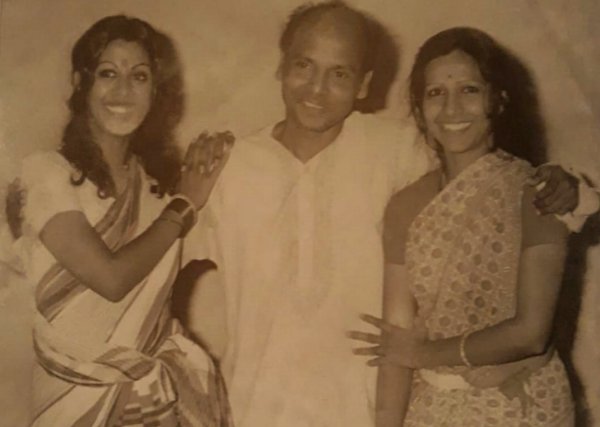 Protima Bedi, Kelubabu & Jaya Dheer during rehearsal of Gita Govinda staged at Mumbai in 1975 Photo courtesy: Ratikant Mohapatra When Sonal was engaged to Lalit Mansingh and came to Cuttack, Professor Mayadhar Mansingh, her father-in-law and a great poet, arranged for her to study Odissi under Guruji. Sonal had seen Kum Kum's Odissi photos and was keen to learn it. I happened to be in Cuttack then. She asked me to come to watch. Babubhai Doshi has produced the film Matir Manisha directed by Mrinal Sen in which Sarat Pujari has acted. He had come to visit me at Babubhai Doshi's residence. I was to leave for Mayadhar Mansingh's residence and he came along as he knew Mansingh well. Guruji was composing the ashtapadi Kuru Yadu Nandana. I shall never forget the way he sat as Radha. Radha had requested Krishna to re-arrange her hair. She raised her finger on which there was a ring studded with mirror. Krishna came from behind to do the hair. His face reflected in the small mirror on the ring which Radha was wearing. Seeing that Radha was overcome with shyness, Krishna lifted her head and kissed her. Ah, what an imaginative way he created from nowhere a ring with a small mirror on Radha's finger, how he went back and held Radha's hair and how his face was reflected in the small mirror! We all were spellbound. Poet Elliot's words, 'who gave eyes as mirror to women' as it were came alive! This was permanently etched in my memory. Another sequence was of Radha and Krishna's physical union. The way the two were united with such intensity, that the poet uses the metaphor 'Daran varan kandare', comparing the intensity with the energetic attack of a lion on the forehead of an elephant. Guruji just stood with eyes lowered, hands near his lower part of the body, with hasta mudra conveying the union. What minimalism, connoisseurs would say. Sarat Pujari always thanked me whenever we met in Bhubaneswar. Guruji's imaginative choroegraphy has won him highest regards. One more sequence from ashtapadi is remarkable. The sakhi tells Radha that waiting for you he has prepared a bed of flowers and is looking in all directions. Even when a leaf falls from the branch of a tree, he is startled and thinks you are coming. Guruji created a bird that flew and sat on the branch of the tree, with the result that a leaf got separated from the branch and flew down swimming in the air. Patati patatre... found a felicitous expression in such choreography. The falling of the leaf had to have a reason why it fell. Therefore from nowhere Guruji brought a bird which sat on a branch and then the leaf fell. Even the gentle murmur of falling leaf, says the poet, made him look for arrival of Radha! I can go on and on having witnessed the choreography when he was creating for Gita Govinda. The prayer 'Shrita Kamala kucha mandala' had so many images that Guruji brought alive. Garudasana, ten-headed Ravana's annihilation and other sequences we can never forget. His choreography of Ramayana, the killing of Jatayu bird by Ravana and Jatayu's fight are evergreen. The way the golden deer jumps when Sita watches it is so exquisite that you never tire of watching it. 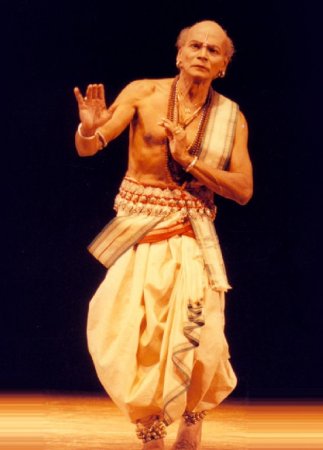 Kelubabu Photo courtesy: Srjan As a young dance critic, I was lucky to attend international festivals like Avignon Festival in South of France in July1995 where Guruji, Pandit Birju Maharaj and Guru Vempati Chinna Satyam were invited to participate. The world renowned German choreographer Pina Bausch was also present. One evening, Guruji was performing Pashyati dishi dishi, looking in all directions. He was performing on a natural stage made of a monument which had columns in a corner. While dancing, Guruji entered one of those columns and started looking in a direction as if seeing if Krishna was arriving from somewhere near the column. The way he covered the stage and looked from the column was imaginative on the spot touch, which the audience applauded with relish. In Mumbai at NCPA also, the stage had cascades of long flower curtain on one side. Guruji turned the curtain to look for Krishna's arrival. Such touches always won him rounds of applause for his spontaneity. And the duet between Birju Maharaj and Guruji 'Bihari ko bas kara lungi' has become a folklore ever to be remembered in the dance world. Birju Maharaj sat in various ways and as Radha, Guruji enacted abhinaya with such delicacy and humility, washing Krishna's feet, pressing them, offering him betel leaf, fanning him and sitting at Krishna's feet looking at him with loving eyes which never blinked. Birju Maharaj was so moved seeing Guruji's abhinaya that after the performance was over he embraced Kelubabu with tremendous admiration. I have been fortunate to witness all these. It so happened that I was at the right spot at the right time. That was my luck. Guruji's love never diminished. When my Marg book on Odissi was ready, he suggested that we release it at the inner sanctum sanctorum of Puri temple at the feet of Lord Jagannath with puja. The book was placed at the feet of the lord and the pujari placed flowers on it and returned the book to Guruji. Such a book release has never happened. We were blessed. The book was then deposited at Raghunandan Library opposite the temple. I would like to end here. The days spent with Guruji are the most precious days of my life.  Dr. Sunil Kothari is a dance historian, scholar, author and critic, Padma Shri awardee and fellow, Sangeet Natak Akademi. Dance Critics' Association, New York, has honoured him with Lifetime Achievement award. Post your comments Please provide your name and email id when you use the Anonymous profile in the blog to post a comment. All appropriate comments posted with name and email id in the blog will also be featured in the site. |